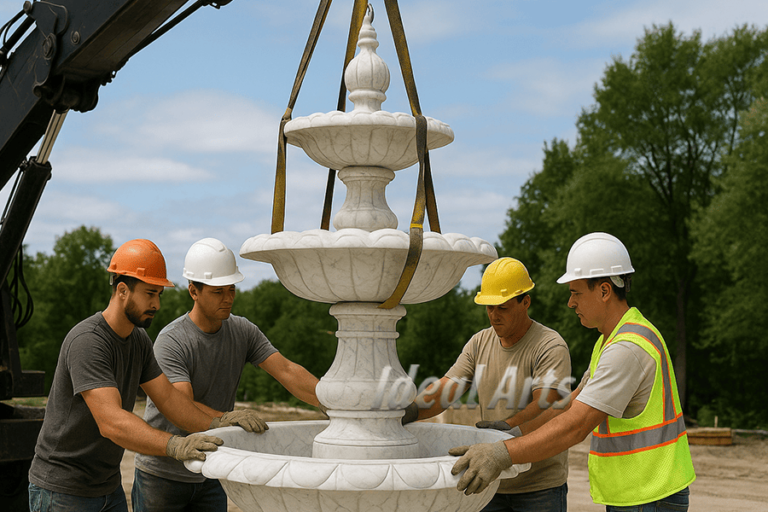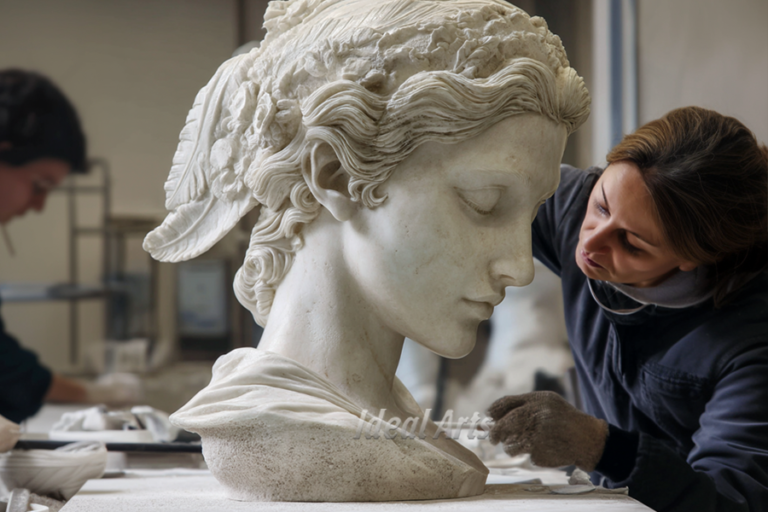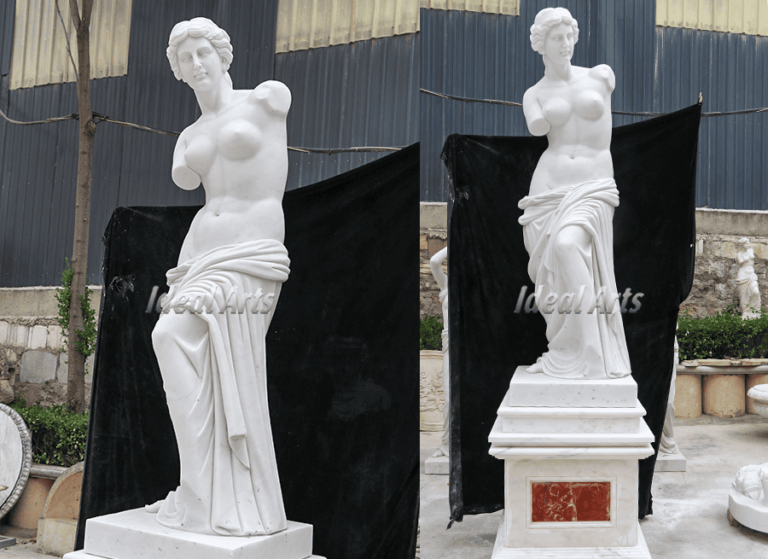What Exactly Is a Marble Bust?
A marble bust is a sculpture that usually shows a person’s head, neck, and upper chest. It’s a portrait made out of stone. Marble busts are different because they’re not just any portrait. They’re immortal portraits. Marble is used because it’s super tough and lasts a long time. It’s also easy to carve into really detailed stuff, like the curl of a lip or the folds of clothing. But more than that, marble busts represent a desire to preserve legacy, to make your mark in the most literal sense – carved in stone.

Why Marble?
Marble has been the go-to material for sculptors since ancient times, and for good reason. It has a fine grain that allows for intricate detailing. Its translucent quality mimics the smoothness of human skin, making it the perfect medium for capturing the nuances of a face. And as it ages, marble develops a natural patina, which only adds to its beauty and authenticity.
But it’s not just about looks. Marble busts are also super tough. While some art forms break down over time, a well-preserved marble bust can last for centuries. It’s like a symbol of immortality – and it’s a symbol you can put in your living room.
Popular Uses of Marble Busts Today
Marble busts aren’t just for art galleries or museums anymore. Interior designers and art enthusiasts are using busts as decorative pieces that add a touch of classical elegance to modern spaces. Whether it’s on a fireplace mantel, a bookshelf, or as the centerpiece of a room, a marble bust is a surefire way to get people talking and show off your refined taste.
But it’s not just about looks. Busts are meaningful. They embody history, culture, and a connection to the past. As homes and offices move toward minimalist, sophisticated design, busts are finding new relevance. They’re timeless accents that ground contemporary environments with a sense

What Is the Meaning of Marble Busts?
Why were busts so fascinating to people in the past (and still today!)? That’s where the meaning comes in.
Busts have been symbols of power, identity, and memory for centuries. In ancient Rome, if you were a big deal – like an emperor, military general, or wealthy noble – getting your bust made was a power move. It was like saying, “Look at me! I’m important, and even after I’m gone, my stone-carved face will still be here to remind you of that.”
But it’s not just about ego (though, let’s be honest, that was a part of it). Busts were about remembrance. Before there were photos or even realistic paintings, a marble bust was one of the few ways to remember what someone looked like for generations. It’s like how we treasure photos of our ancestors – only instead of a photo, you’ve got a 100-pound piece of art staring back at you. Talk about making an impression!
The meaning of marble busts lies in their symbolism of knowledge, authority, and immortality. In ancient Greece and Rome, marble busts were created to immortalize gods, leaders, and philosophers. They were not just art; they were symbols of the divine, of leadership, and of intellectual achievement. In many ways, a marble bust is a reflection of what its subject stood for. Whether it’s a bust of a political figure, a scholar, or a loved one, the material and craftsmanship convey a sense of permanence and respect. Even today, marble busts can be seen as symbols of prestige, culture, and an appreciation for timeless art.
The History of Marble Busts
The origin of marble busts can be traced back to ancient civilizations. In these civilizations, stone carving was used to preserve the image and spirit of individuals. While full statues were common, the bust – typically from the chest or shoulders up – emerged as a powerful symbol of status and immortality.
1、Greece: Celebrating Gods, Heroes, and Philosophers(Where It All Began)
The tradition of marble busts started in ancient Greece. Sculptors in Greece were known for being able to make sculptures that looked exactly like gods, heroes, and important people. They would make these marble busts to honor the gods and put them in their temples. The Greeks were the first to be able to make sculptures that looked like real people, and they set the standard for everyone who came after them.
Notable Examples: The marble bust of Homer, the ancient poet of the Iliad and the Odyssey, is one of the most iconic representations of wisdom and artistic mastery from ancient Greece.

2、Rome: Bigger, Bolder, and Very, Very Realistic(The Rise of Realism and Political Propaganda)
The Romans took the tradition of marble busts and made it even better. They loved everything to be big and dramatic. While the Greeks focused on making things beautiful, the Romans focused on making things look real. They would put all of the details on a person’s face, like wrinkles and scars. It was like they invented Instagram filters – they wanted to show their faces just as they were, without hiding anything. The marble busts they made were like their Instagram profiles – they showed not just their faces, but who they were, what they did, and even their flaws.
Roman emperors used marble busts to show power. Imagine walking into a palace and seeing your ruler’s stern face staring you down. Yeah, that’s one way to say, “I’m in charge.”
The Roman Empire took the idea of marble busts and made it even better. They used marble busts to show off their leaders, military generals, and even regular people who had done something important. They would use busts to celebrate big political achievements and victories. They would put these busts in public places like forums or in private homes to show how important the person was. The Roman Empire used marble busts to show how powerful and important their leaders were.

Here’s a cool fact: Roman marble busts often showed what the person really looked like. They would show things like wrinkles, scars, and other signs of aging. This was different from the Greek marble busts, which showed people as perfect and beautiful.

Notable Example: The bust of Emperor Augustus demonstrates the blend of realism and idealism, portraying him as eternally youthful and strong, symbolizing the strength and continuity of his reign.
3、The Renaissance: Where Art Meets Eternity
Fast forward to the Renaissance. This was the era of Michelangelo, Leonardo da Vinci, and the revival of classical art. Marble busts came back in a big way! Artists in the Renaissance loved the classical Greek and Roman styles, but they added their own touch of humanism and emotion. combining the technical skills of ancient sculptors with a fresh perspective on human anatomy and emotion.You’ll see more expression in Renaissance busts, a little twinkle in the eye, or even a slight smirk.During this time, busts became more than just representations of power—they were also seen as studies of the human form, capturing the inner emotions and personalities of the subjects.
Honestly, if I lived in the Renaissance, I’d totally commission a bust of myself. I mean, who wouldn’t want to be remembered as a perfectly carved piece of marble art?
Busts of Renaissance figures, such as poets, scholars, and religious leaders, were often placed in churches, palaces, and public spaces as symbols of enlightenment and knowledge. The focus was not just on the exterior likeness but on conveying the inner character and significance of the individual.
4、 Baroque and Neoclassicism: Expressive and Elegant Portraiture
During the Baroque era, artists began to experiment with new techniques and styles, moving away from the rigid and static forms of the Renaissance. This shift can be seen in the world of sculpture as well, with marble busts becoming more expressive and elaborate. Sculptors in the 17th and 18th centuries focused on creating busts that were full of movement and emotion, often using dramatic lighting to highlight the subject’s features.
One of the main ways that sculptors added movement to their busts was through the use of flowing hair and drapery. Instead of keeping the hair and clothing of their subjects smooth and controlled, Baroque sculptors allowed these elements to billow and swirl around the subject’s face and body. This created a sense of motion and energy in the bust, making it feel more alive and dynamic.

In addition to adding movement to their busts, Baroque sculptors also added elaborate details. They carved intricate patterns and designs into the hair, clothing, and accessories of their subjects. They also added things like jewelry and other accessories to the bust to make it feel more ornate. These details helped to make the bust feel more luxurious and elegant, which was a common theme in Baroque art.
Overall, Baroque busts are characterized by their dynamic lighting and movement, as well as their flowing hair, drapery, and elaborate details. They are elegant and expressive, capturing the energy and emotion of the Baroque era.
- Gian Lorenzo Bernini: Master of Baroque Busts
Gian Lorenzo Bernini was one of the most famous sculptors of the Baroque period, known for his ability to create incredibly detailed and expressive busts. His sculptures were so lifelike that they appeared to breathe and move, with intricate details that captured the softness of skin and the texture of hair.
One of Bernini’s most famous busts is his Bust of Pope Urban VIII. This sculpture is a perfect example of Bernini’s ability to create realistic and expressive portraits. The bust captures the Pope’s features in incredible detail, from the lines on his face to the texture of his skin. The expression on the Pope’s face seems to change depending on the angle from which it is viewed, giving the sculpture a sense of life and movement.



- Neoclassicism: The Return to Simplicity
The Neoclassical period, which followed the Baroque, was a time when artists sought to return to the simplicity and elegance of classical antiquity. Neoclassical busts were characterized by clean lines, restrained emotion, and a sense of idealized beauty. They often depicted prominent figures of the Enlightenment, such as philosophers and influential thinkers.
One of the most famous Neoclassical busts is Jean-Antoine Houdon’s marble bust of Voltaire. This sculpture exemplifies the Neoclassical approach, combining a realistic portrayal of the subject with an air of intellectual refinement. Houdon captures Voltaire’s features in incredible detail, from the lines on his face to the texture of his hair. The expression on Voltaire’s face is calm and thoughtful, reflecting the intellectual nature of the Enlightenment.
Houdon’s marble bust of Voltaire is a perfect example of the simplicity and elegance of Neoclassical portraiture. It captures the essence of the Enlightenment and the ideals of the Neoclassical period, and serves as a reminder of the power of classical antiquity.


5、Modern Day: A Personal Touch
Nowadays, marble busts are still being created, but with a more personal touch. People are commissioning busts of themselves, family members, or even their pets. While we may not have the power-hungry emperors of ancient Rome, we still have people who want to immortalize themselves or their loved ones in marble. The allure of marble busts has not faded, even if the subject matter has changed.

Marble busts have come a long way from their origins as a way to immortalize gods and emperors. They have captured the hearts and imaginations of people throughout history, telling stories and leaving their mark on the world. From the power and grandeur of the Roman emperors to the emotion and expression of the Baroque era, marble busts are a timeless art form that continues to captivate.
Whether you are a lover of art, a history buff, or just someone who thinks it would be cool to have a marble bust of yourself (and who wouldn’t?), marble busts are worth appreciating. They are more than just sculptures—they are legacies in stone.






